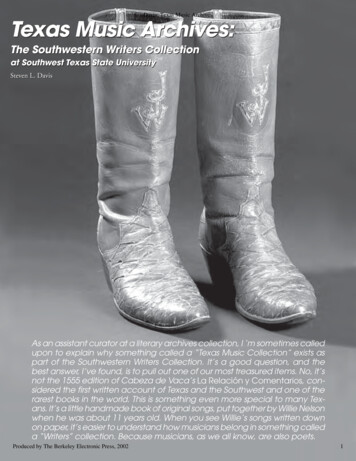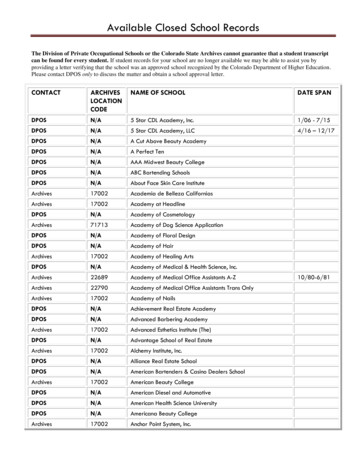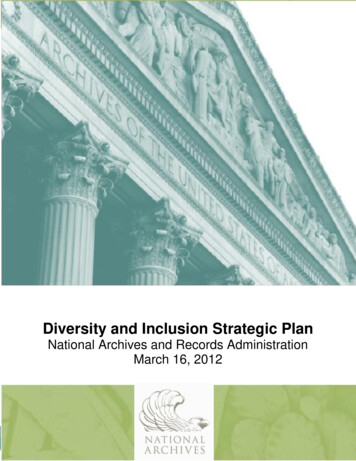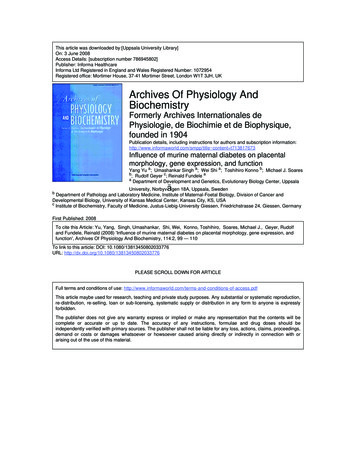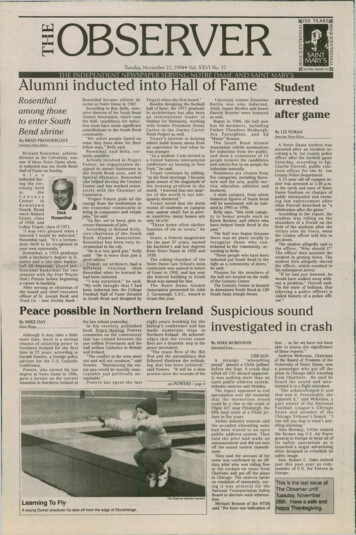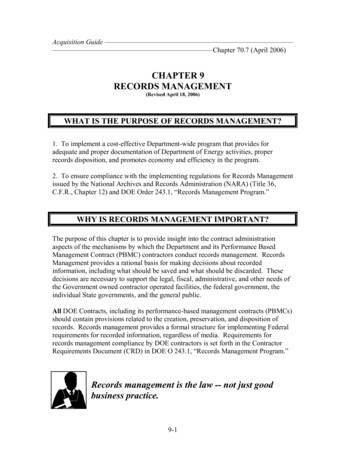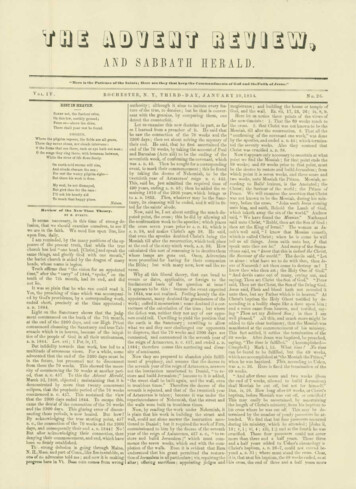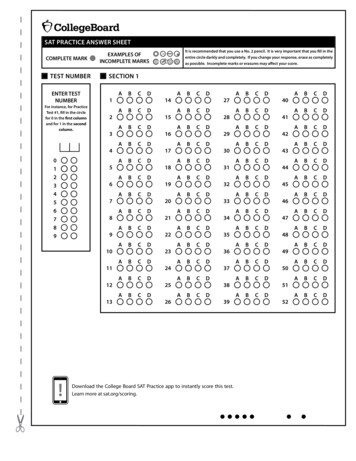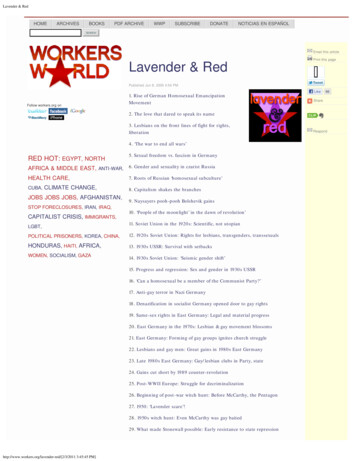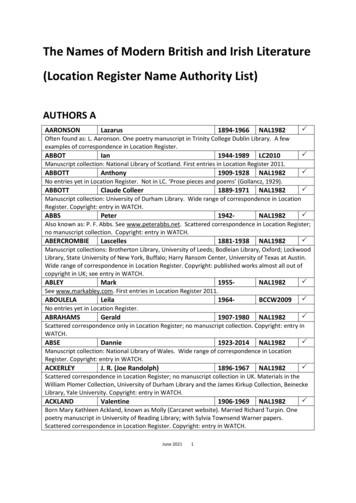
Transcription
“OK, We'll Go”Just What Did Ike Say When He LaunchedThe D-day Invasion 70 Years Ago?By Tim Rives
An elusive D-day mystery persists despite the millions of words written aboutthe allied invasion of normandy on June 6, 1944: What did gen. DwightD. eisenhower say when he gave the final order to launch the attack?It is puzzling that one of the most important decisions of the 20th century did notbequeath to posterity a memorable quote to mark the occasion, something to live upto the magnitude of the decision. something iconic like gen. Douglas macarthur’svow to the people of the Philippines, “I shall return.”The stakes of the invasion merited verbal splendor if not grandiloquence. Ifoperation overlord failed, the allies might never have won the war. yet eyewitnessesto eisenhower’s great moment of decision could not agree on what he said.as for eisenhower, he could not even agree with himself: he related five versionsof his fateful words to journalists and biographers over the years. even more mysteri ously, he wrote five different versions of the statement in a 1964 article commemorat ing the 20th anniversary of D-day.to put his words—whatever they may have been—into context, the high drama ofthe meetings leading up to the invasion decision 70 years ago bears repeating.Eisenhower ReliesOn His Weathermanall the elements for the D-day attack were in place by the spring of 1944: morethan 150,000 men, nearly 12,000 aircraft, almost 7,000 sea vessels. It was arguablythe largest amphibious invasion force in history. every possible contingency had beenplanned for. every piece of equipment issued. every bit of terrain studied. The inva sion force was like a coiled spring, Ike said, ready to strike hitler’s european fortress.all it waited for was his command, as supreme commander, allied expeditionaryforce, to go.But for all the preparation, there were critical elements eisenhower could not con trol—the tides, the moon, and the weather. The ideal low tidal and bright lunarconditions required for the invasion prevailed only a few days each month. The datesfor June 1944 were the fifth, the sixth, and the seventh. If the attack was not launchedon one of those dates, Ike would be forced to wait until June 19 to try again. any waitrisked secrecy. Delay would also cut into the time the allies had to campaign duringthe good summertime weather.“The inescapable consequences of postponement,” Ike wrote in his 1948 memoirCrusade in Europe, “were almost too bitter to contemplate.”Ike and his staff began meeting in early June to choose the final invasion date, a daynow contingent on the best weather forecast. The setting was southwick house, nearPortsmouth, in southern england. The conference room where they met was large,a 25-by-50-foot former library with floor-to-ceiling french doors, dark oak panel ing, and a blue rug on which Ike would pace anxiously in the days leading up to theinvasion. empty bookshelves lined the room, a forlorn reminder of its now decidedlyunliterary purpose.Ike, his commanders, and his weather team, led by group captain J. m. stagg,met in the library twice a day, at 4 a.m. and 9:30 p.m. on the evening of saturday,June 3, stagg reported that the good weather england experienced in may had movedOpposite: General Eisenhower talks with paratroopers of the 101st Airborne Division in Newbury,England, on June 5, 1944, prior to their boarding for the invasion.“OK, We’ll Go”Prologue 37
An aerial view of Operation Overlord, the largest amphibious invasion force in history, shows landing craft, barrage balloons, and allied troops landing in Normandy, France.out. a low was coming in. he predictedJune 5 would be cloudy, stormy, windy,and with a cloud base of zero to 500 feet.That is, it would be too windy to disembarktroops in landing craft and too cloudy forthe all-important preparatory bombardmentof the german coastal defenses. The groupreconvened early the next morning to givethe weather a second look. The forecast wasno better, and eisenhower reluctantly post poned the invasion.“How long can you . . .let it hang there.”The group gathered again at 9:30 theevening of sunday, June 4. Ike opened the38 Prologuemeeting and signaled for stagg to begin.stagg stood and reported a coming break inthe weather, predicting that after a few morehours of rain would come 36 hours of clearerskies and lighter winds to make a June 6 in vasion possible. But he made no guarantees.The commanders debated the implicationsof the forecast. They were still struggling to ward consensus when eisenhower spoke.“The question,” he said, “is just how longcan you keep this operation on the end of alimb and let it hang there.”The order, he said, must be given. slowerships received provisional orders to sail. ButIke would wait until the next morning tomake the decision final. he ordered the mento return again in the early hours of June 5.Ike rose at 3:30 and traveled the muddymile from his camp to southwick housethrough withering rain and wind. stagg hadbeen right. If the invasion had started thatmorning, it would have failed.Ike started the meeting. stagg repeatedhis forecast: the break in the weather shouldhold. his brow as furrowed as a Kansascornfield, eisenhower turned to each ofhis principal subordinates for their finalsay on launching the invasion the next day,tuesday, June 6, 1944. gen. Bernard Lawmontgomery, who would lead the assaultforces, said go. adm. sir Bertram ramsay,the naval commander in chief, said go. airSpring 2014
Above: Operation Overlord commanders meet in London, January 1944. Left to right: Lt. Gen. Omar Bradley,commanding U.S.Army Ground Force: Adm. Sir Bertram Ramsay,Allied Naval Commander; Air Chief MarshalSir Arthur Tedder, Deputy Supreme Commander; Gen. Dwight D. Eisenhower, Supreme Commander; Gen.Bernard Montgomery, Commander in Chief; Air Chief Marshal Sir T. Leigh-Mallory; Lt. Gen. Walter BedellSmith. U.S. Army. Right: Gen. Dwight D. Eisenhower, Supreme Commander, Allied Expeditionary Forces.Only he could decide on a date for the D-day invasion based on weather and tidal conditions; continuedpostponement would have been disastrous.chief marshal sir trafford Leigh-mallory,the air commander in chief, said go.eisenhower stood up and began walkingback and forth on the war room’s blue rug,pondering the most important decision ofhis life and the fate of millions. It was nowup to him. only he could make the deci sion. he kept pacing, hands clasped behindhis back, chin on his chest. and then hestopped. The tension left his face. he lookedup at his commanders and said . . . what?This is where history draws a blank.What did Ike say when he launched theD-day invasion? Why is there no single,memorable quote?Ike Gave the Order,But What Did He Say?The eyewitnesses offer answers but littlehelp. of the 11 to 14 men who attendedthe final decision meeting—the numberis also in dispute—only four men besideseisenhower reported what they believed werethe supreme commander’s historic words.The accounts of three witnesses appeared inmemoirs published between 1947 and 1969.Lt. gen. Walter Bedell smith, who asIke’s chief of staff probably spent more timewith him than anyone else during the war,reported, “Well, we’ll go!” in his memoir,“OK, We’ll Go”Eisenhower’s Six Great Decisions (1956). maj.gen. francis De guingand, field marshalmontgomery’s chief of staff, noted, “We willsail tomorrow” in Operation Victory (1947).In Intelligence at the Top (1969), maj. gen.Kenneth strong, whom Ike described as thebest intelligence officer he had ever known,said, “oK, boys. We will go.”admiral ramsay died in an airplane crashduring the war and left no memoir. his ver sion survives through the reporting of allanmichie of Reader’s Digest. michie publishedthe story behind the ramsay quote in his 1964book, The Invasion of Europe. It is the best ac count available to historians of a contempo rary journalist attempting to verify Ike’s words.michie writes how he began his questfor the elusive phrase on June 5, pressingramsay for the moment-by-moment detailsof the final meeting at southwick house.ramsay was fluently unrolling his story un til he reached the moment of Ike’s decision.There he stalled. “What did eisenhower say?What words did he actually use?” michieasked. “I can’t quite remember,” ramsaysaid, but it was “a short phrase, somethingtypically american.” michie pepperedramsay with possibilities, all of which theadmiral dismissed until the correspondenthit upon “ok, let ’er rip.” ramsay tentativelyconfirmed it, but warned michie that hewould need eisenhower’s agreement.michie hurried to Ike’s command trailerand asked an aide for eisenhower’s impri matur. The aide returned a few minutes laterand told michie that if he and ramsay agreedon the phrase, it was good enough for Ike. amilitary censor forced michie to get the quotereconfirmed a few days later when he at tempted to cable his article to Reader’s Digest.eisenhower obliged, and “ok, let ’er rip” ap peared in the magazine’s august 1944 issue.A Much-Used “OK, We’ll Go”Picked Up by Some Historiansmichie’s story impressed eisenhower’sBritish military assistant, col. James gault,who noted the article in his diary. gaultlent his diary to Kenneth s. Davis, an earlyeisenhower biographer, who arrived at Ike’sheadquarters in august 1944.notes from the diary found in Davis’s per sonal papers confirm that he was aware ofmichie’s version, but he published his ownD-day quote in his 1945 book, Soldier ofDemocracy. “all right,” Davis writes, “Wemove.” Davis presumably got this fromeisenhower in one of his three interviewswith the general that august, but his papersdo not contain verbatim notes.Prologue 39
The Davis book was backed by miltoneisenhower, Ike’s youngest brother. The pres ident of Kansas state college (now Kansasstate university), milton recruited Davisto write the biography “so that at least onegood one is produced.” The book, miltonassured Ike, “promises to be one of real valuein the war effort on the home front and tohave real historical information.”although Ike would have qualms withDavis’s book—he thought the author over emphasized class conflict in his abilene,Kansas, hometown—he had no hesitationlater in recommending it to a man who“wanted to know what your thoughts wereat 4 a.m. on that day when you had to makethe great decision.” additionally, whileeisenhower made 250 annotations in hiscopy of the book, he did not comment onDavis’s version of the quote.another wartime writer, chester Wilmotof the BBc, reports “ok, we’ll go” in TheStruggle for Europe (1952). Wilmot inter viewed eisenhower twice—on august 11,1944, and again on october 16, 1945. hesubmitted his questions to the general be fore the 1945 interview. Question threeasked specifically for the details of the June5 meeting. Perhaps he got them, but likeDavis, Wilmot’s interview notes contain nodirect evidence of his quote.nevertheless, Wilmot’s version is con firmed by eisenhower in the cBs documen tary “D-Day Plus 20 years,” an anniversaryspecial filmed on location in england andfrance in 1963. It aired on June 6, 1964.Walter cronkite interviewed Ike in thesouthwick house war room where he madethe decision. In this interview, Ike said, “Ithought it [the likely weather] was just thebest of a bad bargain, so I said, ‘ok, we’ll go.’”Several versions of Eisenhower’s D-day words havebeen reported, and the general himself was not con sistent in his recollections. In a 1964 article for ParisMatch, he recalled his historic statement as, “We willattack tomorrow.”40 PrologueTo learn more about The life of Dwight eisenhower, go to www.eisenhower.archives.gov/. World War II and how to do research on it, go to www.archives.gov/research/military/ww2/. getting your militar y separation papers to qualif y for federal programs, go to www.archives.gov/research/military/ww2/.Spring 2014
Eisenhower Never ChallengesDifferent Versions of Quoteeisenhower had the chance to amend hiswords when he reviewed galley proofs of theinterview transcripts prepared for publica tion in the New York Herald Tribune by his torian martin Blumenson. Ike made almost80 revisions to the text but did not touch theD-day quote.a similar version of the Wilmot/cronkitequote is stephen ambrose’s “ok, let’s go,”which appears in his many World War IIbooks. In The Supreme Commander (1970),ambrose claimed he garnered it fromeisenhower during an october 27, 1967, in terview. “he was sure that was what he said.”But Ike’s post-presidential records disprovehis claim. he didn’t see ambrose that day.he was playing golf in augusta, georgia,not revisiting the past. furthermore, inambrose’s book, D Day: June 6, 1944, TheClimatic Battle of World War II (1994), hemistakenly attributes the quote to the 1963cronkite interview.The confusion over Ike’s D-day wordswould spread beyond the english-speakingworld. claus Jacobi of the german maga zine Der Spiegel interviewed eisenhower athis Palm Desert, california, vacation homeon may 6, 1964. his version approximatesthe Wilmot/cronkite quote, adding oneword: “ok, we’ll go ahead.” eisenhower re viewed Jacobi’s article before publication,but as usual did not comment on the quote,although he did strike out the statement thatthe allies would have dropped atomic weap ons on germany had the invasion failed.Even Eisenhower HimselfCouldn’t Decide on Wordingeisenhower never once commented on orcorrected the different quotes he found in thework of journalists, biographers, or formercomrades. But neither did he use them in hismost detailed account of the June 5 meeting.nor for that matter did he use his own mostrecent statement. Instead, eisenhower wrote“OK, We’ll Go”five different versions of the quote in drafts ofa 1964 article for the Paris Match.The Paris Match article was about D-day,but it had a contemporary strategic purposeas well. france was becoming more andmore independent of the north atlantictreaty organization at the time. remindingthe french of their shared sacrifice duringthe second World War might strengthentheir bond with the allies. as Jean monnet,a leading advocate for european unity, saidto Ike in a telegram: “I feel sure that an ar ticle by you at this moment on the landingwould be politically most important.”given this importance, Ike presumablyput a lot of thought into the story, whicheither makes the various versions it con tains more perplexing, or it explains them.eisenhower may have been searching for justthe right words to inspire french readers.In his notes for the article, Ike wrote,“yes, we will attack on the 6th.”In the first full draft of the story, hesaid, “yes, gentlemen, we will attack onthe 6th.”In the penultimate draft, Ike scratchedthis out and wrote, “gentlemen, wewill attack tomorrow.”elsewhere in the draft, referring back tohis decision, he said, “We will make the at tack on June 6,” which he then marked outand wrote, “We will attack tomorrow.”In the final draft he makes two referencesto the decision: “We will attack tomorrow”and “gentlemen, we will attack tomorrow,”thereby demonstrating once again his appar ent lack of concern with exactly what he saidin the early morning hours of June 5, 1944.The Paris Match article appeared withindays of the New York Herald Tribune series,the cBs airing of “D-Day Plus 20 years,”and the Der Spiegel article. Three differ ent eisenhower quotes in three languageswere put before the international public atthe same time. The quote was lost beforethere was even a chance for it to be lost intranslation.What accounts for all these versions ofIke’s D-day words? The historian Davidhowarth perhaps captured it best in his de scription of the June 5 meeting:nobody was there as an observer.however high a rank a man achieves,his capacity for thought and feeling isonly human, and one may imagine thatthe capacity of each of these men wastaxed to the limit by the decision theyhad to make so that none of them hadthe leisure or inclination to detach hismind from the problem and observe ex actly what happened and remember itfor the sake of historians.Confusion Also ReignsOver Time of DecisionThe stress confounding the commandersobscured other key details of the meeting:What time did they meet? Who was there?Was Ike sitting or pacing when he made thedecision? how long did it take him to makeup his mind?various eyewitnesses place the June5 meeting at 4:00, 4:15, and 4:30 a.m.eisenhower was nearly as inconsistent withthe time as he was with his words. In the ear ly Paris Match drafts, he states he made thefinal decision at 4:00, but in the last draft hesays the meeting started at 4:15. his 1948war memoir records that he made the de cision at 4:15. field marshal montgomeryputs the decision at 4:00 in his 1946 accountof the meeting, but at 4:15 in his memoir12 years later. another six eyewitnesses whonoted the time of the meeting cast one votefor 4:00, four for 4:15, and one for 4:30.francis De guingand omits the June 5 datealtogether and places the final decision onthe night of June 4.The identity of the eyewitnesses is ques tioned by . . . the eyewitnesses.a June 5, 1944, memorandum by op erations planner maj. gen. harold Bullnames eisenhower, montgomery, ramsay,air chief marshal sir arthur tedder,Prologue 41
A view from a Coast Guard barge hitting the French coast with the first waves of invaders. American fighting men wade ashore under heavy machine-gun fire fromNazi beach nests, June 6, 1944.Leigh-mallory, air vice marshal Jamesrobb, rear admiral george creasy, smith,strong, and De guingand as present. Insome accounts stagg attended the meetingbut left before the decision was made. airvice marshal robb had his own list, whichadds gen. sir humfrey gale, Ike’s chief ad ministrative officer, and air vice marshalh.e.P. Wigglesworth. eisenhower is alone inincluding gen. omar Bradley in his accountof the final meeting, but Bradley wrote inhis 1951 war memoir that he was aboard theuss Augusta at the time of Ike’s decision.The eyewitnesses—a designation rapidlylosing its force—further disagree on Ike’smovements during the final decision meet ing. eisenhower paced the room in the42 Prologueaccount shared above, which came fromgeneral strong. But general smith assertsthat Ike sat. But was it on a sofa, as smithwrites? or at a conference table, as generalDe guingand says? or in an easy chair, asthe weatherman stagg remembers?and how long did it take eisenhower tomake up his mind once his commanders hadgiven their opinions? Was it the 30 to 45 sec onds he recalled in 1963? or “a full five min utes” as smith recorded in his 1956 memoir?eisenhower pondered these discrepanciesin later years. While he did not directly in voke David howarth’s “fog of war” explana tion in his unpublished 1967 essay, “Writinga memoir,” he agreed with its implications.he wrote:When accuracy is all important,memory is an untrustworthy crutch onwhich to lean. Witnesses of an accidentoften give, under oath, contradictorytestimony concerning its details onlyhours later. how, then, can we expecttwo or more individuals, participants inthe same dramatic occurrence of yearspast, to give identical accounts of theevent?With Eisenhower, There WereNo Theatrics, Just ModestyBut there is more to the mystery of Ike’sD-day words than the inability of memoryto preserve the past. eisenhower’s humblecharacter contributes to the riddle. andSpring 2014
Eisenhower penned a quick, direct note explaininghis decision in case the D-day landing failed (writingJuly instead of June in his haste).The note reveals hisconcern with the consequences rather than how hegave the order.while his character alone cannot solve themystery, it may explain why there is no sin gle, memorable quote.Ike disdained pomposity in word andmanner. he disliked the “slick talker” andthe “desk pounder.” The histrionic gesture ordeclamation just wasn’t in him.as his biographer Kenneth s. Daviswrites, “There was nothing dramatic inthe way he made [the decision]. he didn’tthink in terms of ‘history’ or ‘destiny,’ nordid there arise in him any of that gran diose self-consciousness which character izes the decisive moments of a napoleonor hitler.”everything about eisenhower was re strained, D-day historian cornelius ryanadds. “apart from the four stars of hisrank, a single ribbon of decorations abovehis breast pocket and the flaming shoulderpatch of shaef, eisenhower shunned alldistinguishing marks. even in the [com mand] trailer there was little evidence of hisauthority: no flags, maps, framed directives,or signed photographs of the great or neargreats who visited him.”“OK, We’ll Go”There is no memorable quote, in otherwords, because of eisenhower’s good oldfashioned Kansas modesty. he did not havethe kind of ego that spawns lofty sentimentsfor the press or posterity. Ike was a plainspeaker from the plains of america’s heart land. contrast this with Douglas macarthur,whose “I shall return” was carefully composedfor press and posterity. (The u.s. office ofWar Information preferred, “We shall return”but lost the fight to the lofty macarthur.)eisenhower’s self-effacing character is alsorevealed in his other D-day words, words henever intended anyone to hear. The wordsshow he was far more concerned with tak ing responsibility for failure than with glo rying in whatever success crowned D-day.During the somber lull between the decisionand the invasion, Ike scribbled a quick noteand stuffed it in his wallet, as was his custombefore every major operation. he misdatedit “July 5,” providing more evidence of thestress vexing him and his subordinates. hefound the note a month later and showedit to an aide, who convinced him to save it.The note said simply:our landings in the cherbourg-havrearea have failed to gain a satisfactory foot hold and I have withdrawn the troops.my decision to attack at this time andplace was based upon the best informa tion available. The troops, the air and thenavy did all that Bravery and devotionto duty could do. If any blame or faultattaches to the attempt it is mine alone.eisenhower’s D-day worries lay with theconsequences of his decision, not the stylein which it was uttered. and while the re sult of his D-day decision is well known, hiswords unleashing the mighty allied assaulton normandy will remain a mystery, just theway he would have wanted it. Pnote on sourcesThe faint trail connecting the sources used forthis article begins in the holdings of the DwightD. eisenhower Presidential Library and museumin abilene, Kansas. The sole mention of his LastWords in the Pre-Presidential Papers of Dwight D.eisenhower, 1916–1952, appears in the Principalfiles series. a similar lone reference is foundin the White house central files, President’sPersonal files series. It is not until you examineIke’s Post-Presidential Papers, 1961–1969, thatthe bread crumbs start appearing at regular inter vals. records relating to the D-day invasion andhis fateful words are found in numerous folders inthe series 1963 and 1964 Principal files. his es say on the difficulties of memoir writing is in theaugusta-Walter reed series. The Post-Presidentialappointment Books series proves whether awriter saw eisenhower on the date(s) he claimed.an important memorandum on the June 4 and 5meetings is located in the Lt. gen. harold BullPapers, 1943–1968.helpful sources in other manuscripts reposi tories include the Kenneth s. Davis collection,hale Library, Kansas state university; thechester Wilmot Papers at the national Libraryof australia; and the alan moorehead Papers,also at the national Library of australia. airvice marshal James robb’s account of the June 5meeting is in the archives of the royal air forcemuseum in London. I thank all four institutionsfor their long-distance reference services.This article benefited by the several, if contra dictory, accounts found in the memoirs noted inthe text. David howarth’s D Day: The Sixth ofJune, 1944 (mcgraw-hill Book company, Ltd.:new york, 1959) and cornelius ryan’s oft-cop ied, never-surpassed The Longest Day (simon andschuster: new york, 1959) are among the bestwritten narratives of D-day and provide keen ob servations of the June 5 meeting (howarth) andeisenhower’s character (ryan).I also want to thank Dr. timothy nenninger ofthe national archives and records administrationfor his advice and counsel on D-day records.AuthorTim Rives is the deputy director ofthe eisenhower Presidential Libraryand museum in abilene, Kansas.he earned his master of arts degreein american history from emporia state university in1995. he was with the national archives at Kansas cityfrom 1998 to 2008, where he specialized in prison rec ords. This is his fifth article written for Prologue.Prologue 43
during the war and left no memoir. his ver sion survives through the reporting of allan michie of Reader’s Digest. michie published the story behind the ramsay quote in his 1964 book, he Invasion of Europe. It is the best ac count available to historians of a co
